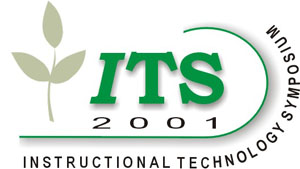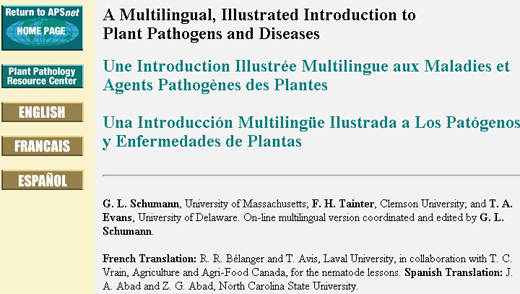On-line multilingual version coordinated and edited by G. L. Schumann Une Introduction Illustrée Multilingue aux Maladies et Agents Pathogènes des Plantes
Una Introducción Multilingüe Ilustrada a Los Patógenos y Enfermedades de Plantas
Introduction The American Phytopathological Society Press has published "A Plant Disease Video Image Resource" which is a laser videodisc of nearly 10,000 images related to plant pathology. The images are from the color plates of the APS Press Compendia series, slide sets, and some additional contributions. The videodisc has been designed to allow basic image research and viewing when used with a videodisc player, monitor, and a computer for the DOS-based searchable database. Each image is described by host plant, pathogen name, disease name, some additional information, and a 5-digit image number. A set of 35 lessons plus a glossary of 850 terms related to plant pathology designed for introductory plant pathology students were created to be used with the videodisc. General information is provided for each major pathogen group followed by some example diseases within each group. The pathogen groups included are: Abiotic Disorders, Fungi (Ascomycetes, Basidiomycetes, Oomycetes), Nematodes, Parasitic Flowering Plants, Prokaryotes, and Viruses. In each lesson, blocks of short text are accompanied by 5-digit numbers that correspond to images on the APS Press videodisc. The educational objectives of these lessons and glossary are:
Word rich text files (.rtf) of all of the lessons and the glossary in three languages (English, French and Spanish) are available. Instructors can easily modify the lessons according to their own instructional needs. The different language versions of the materials may be useful for students whose first language is English, French, or Spanish, and for people planning to study or work in agriculture in areas where these languages are used. Images are accessed using the 5-digit number on a remote control key pad, or the numbers may be replaced by bar codes produced with a computer program. The bar codes are then read with a laser pen. Lessons with bar codes may be photocopied for student use. The lessons could not be provided with bar codes because different videodisc player manufacturers use different proprietary software for their bar codes. This learning resource can be made available to students with only a videodisc player and a video monitor (e.g. a television) for a modest price. Instructors also may use the image collection in lectures with a videodisc player projector. Hardware and software information is provided in each of the three languages. A videodisc student study station can be used to:
The lessons and glossary in three languages are available for free download in the APSnet Education Center at: http://www.apsnet.org/education/Mlingual/top.html (Fig 1). Information about purchase of the APS Press Videodisc Image Resource and videodisc hardware and software is provided at the site. Figure 1. Introduction to the Multilingual Videodisk Website End
|

